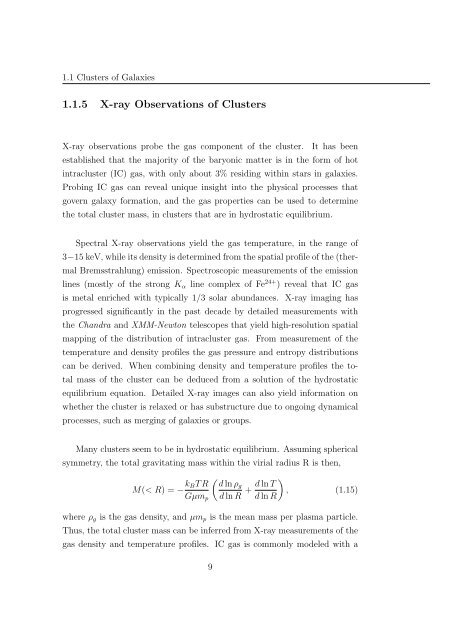Mass and Light distributions in Clusters of Galaxies - Henry A ...
Mass and Light distributions in Clusters of Galaxies - Henry A ...
Mass and Light distributions in Clusters of Galaxies - Henry A ...
Create successful ePaper yourself
Turn your PDF publications into a flip-book with our unique Google optimized e-Paper software.
1.1 <strong>Clusters</strong> <strong>of</strong> <strong>Galaxies</strong><br />
1.1.5 X-ray Observations <strong>of</strong> <strong>Clusters</strong><br />
X-ray observations probe the gas component <strong>of</strong> the cluster. It has been<br />
established that the majority <strong>of</strong> the baryonic matter is <strong>in</strong> the form <strong>of</strong> hot<br />
<strong>in</strong>tracluster (IC) gas, with only about 3% resid<strong>in</strong>g with<strong>in</strong> stars <strong>in</strong> galaxies.<br />
Prob<strong>in</strong>g IC gas can reveal unique <strong>in</strong>sight <strong>in</strong>to the physical processes that<br />
govern galaxy formation, <strong>and</strong> the gas properties can be used to determ<strong>in</strong>e<br />
the total cluster mass, <strong>in</strong> clusters that are <strong>in</strong> hydrostatic equilibrium.<br />
Spectral X-ray observations yield the gas temperature, <strong>in</strong> the range <strong>of</strong><br />
3−15 keV, while its density is determ<strong>in</strong>ed from the spatial pr<strong>of</strong>ile <strong>of</strong> the (thermal<br />
Bremsstrahlung) emission. Spectroscopic measurements <strong>of</strong> the emission<br />
l<strong>in</strong>es (mostly <strong>of</strong> the strong K α l<strong>in</strong>e complex <strong>of</strong> Fe 24+ ) reveal that IC gas<br />
is metal enriched with typically 1/3 solar abundances. X-ray imag<strong>in</strong>g has<br />
progressed significantly <strong>in</strong> the past decade by detailed measurements with<br />
the Ch<strong>and</strong>ra <strong>and</strong> XMM-Newton telescopes that yield high-resolution spatial<br />
mapp<strong>in</strong>g <strong>of</strong> the distribution <strong>of</strong> <strong>in</strong>tracluster gas. From measurement <strong>of</strong> the<br />
temperature <strong>and</strong> density pr<strong>of</strong>iles the gas pressure <strong>and</strong> entropy <strong>distributions</strong><br />
can be derived. When comb<strong>in</strong><strong>in</strong>g density <strong>and</strong> temperature pr<strong>of</strong>iles the total<br />
mass <strong>of</strong> the cluster can be deduced from a solution <strong>of</strong> the hydrostatic<br />
equilibrium equation. Detailed X-ray images can also yield <strong>in</strong>formation on<br />
whether the cluster is relaxed or has substructure due to ongo<strong>in</strong>g dynamical<br />
processes, such as merg<strong>in</strong>g <strong>of</strong> galaxies or groups.<br />
Many clusters seem to be <strong>in</strong> hydrostatic equilibrium. Assum<strong>in</strong>g spherical<br />
symmetry, the total gravitat<strong>in</strong>g mass with<strong>in</strong> the virial radius R is then,<br />
M(< R) = − k (<br />
BT R d ln ρg<br />
Gµm p d ln R + d ln T )<br />
, (1.15)<br />
d ln R<br />
where ρ g is the gas density, <strong>and</strong> µm p is the mean mass per plasma particle.<br />
Thus, the total cluster mass can be <strong>in</strong>ferred from X-ray measurements <strong>of</strong> the<br />
gas density <strong>and</strong> temperature pr<strong>of</strong>iles. IC gas is commonly modeled with a<br />
9
















